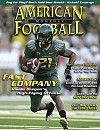Article CategoriesAFM Magazine
|
Drills Report: Teaching The Combo Blockby: Ken WilmesherrOffensive Line Coach, Grossmont College © More from this issue In the combo block, the two adjacent offensive linemen performing the block are identified as a post blocker and a seal blocker. They are blocking a first-level defender (defensive lineman) to a second-level defender (linebacker or possible a safety). When teaching the combo block, I work inside-out when drilling playside combos and backside combos. Playside combos are called Jack, Queen, and King. Jack is a combo block between the center and callside guard working to a playside linebacker. Queen is a combo block between the playside guard and playside tackle working a down defender to a playside linebacker. King is a combo block between the playside tackle and the playside tight end working a down defender to a playside linebacker. I also teach backside combo blocks. Ace is a combo between the center and playside guard working a down defender to a backside linebacker. Deuce is a combo between the playside guard and the playside tackle working to a backside linebacker. Trey is a combo block between the playside tackle and the playside tight end working a down defender to a backside linebacker. When I teach the combo block, at first I will not have a second- level defender. Linemen, especially young linemen, want to come off the down defender too soon, which disallows for the necessary vertical push needed. I tell my linemen, “A down defender makes tackles for losses and a second-level defender makes tackles. Block the first-level defender first.” After offensive linemen properly execute the proper technique on the down defender, I will then put a second-level defender in. The objective of the combo block is to get vertical movement on the down defender and seal the linebacker. It is imperative the post blocker and the seal blocker keep their shoulders square (do not get turned). The position step by the seal blocker is important because he has to be on the proper angle to block the down defender. Make sure he is not stepping underneath himself with the position step which will allow for him to get the hips and shoulders turned, losing power and balance. This allows the defender to possibly split the block. Therefore, it is important that the post blocker and the seal blocker maintain a hip-to-hip relationship on contact, which will not allow the down defender to split the block. The second-level defender, which is usually a linebacker, can do one of three things. He can run through, hang, or scrap over the top. The terms I use when teaching combo blocks are “step, punch, and eyeball”. Both offensive linemen will get vertical push on the down defender (drive the down defender upfield) until the linebacker commits. If the linebacker runs through, it turns into an inside-out combo block. If the linebacker scrapes over the top, it turns into a post-seal combo, and, if the linebacker hangs, we get vertical push on the down defender until the linebacker commits. It is imperative when linemen are performing the combo block to stay on the proper blocking angle until they get to the depth of the linebacker. Also, the second-level defenders alignment may determine whether he will run through or go over the top. The closer the second-level defenders alignment is to the seal blocker, the more likely he will go over the top. After they understand the concept of the combo block, I will then line up two offensive linemen and two defenders, a down defender and a second-level defender. I will place the defender in different alignments. First, I will start with the down defender in an outside shade. King, a down defender is in a 1 tech. Queen, another down defender, is in a 3 tech. King and the down defender are in a 5 tech, all outside shades to the callside. Always give a snap count. On the snap count, both O-linemen will get vertical push on the down defender, while executing the proper technique of the combo block. Look for the proper footwork, pad leverage, the proper punch, hip-to-hip relationship, and eyes on the linebacker. You will then have the down defender align head up on the post blocker and repeat the drill. It is important that you work against all possible stunts by the down defender and the linebacker’s three paths, run through, hang, and scrap over the top. You can work this drill live or against shields. 2. Check to make both blockers maintain the proper hip-to-hip relationship on contact, and maintain until one of them comes off to the linebacker. 3. Check to make sure they are both eyeballing the second level defender. Deuce: is a combo block between the playside guard and the playside tackle, working to the backside linebacker. Trey: is a combo block between the playside tackle and the playside tight end working to the backside linebacker. Queen: is a combo block between the playside guard and the playside tackle working to the playside linebacker. King: is a combo block between the playside tackle and the playside tight end working to the playside linebacker or strong safety. Post Blocker Footwork 1. Determined by alignment (Position). 2. Vertical step (Power). 3. Maintain base. 1. Slide step (Position). 2. Vertical step (Power). 3. Maintain base. Ken Wilmesherr just completed his fifth season as Grossmont College’s O-line coach. He previously coached for three seasons at Southwestern College and has 29 years of coaching experience at the high school and college level. He can be reached at kwilmesh@cox.net |
|
| HOME |
MAGAZINE |
SUBSCRIBE | ONLINE COLUMNISTS | COACHING VIDEOS |
Copyright 2024, AmericanFootballMonthly.com
All Rights Reserved




